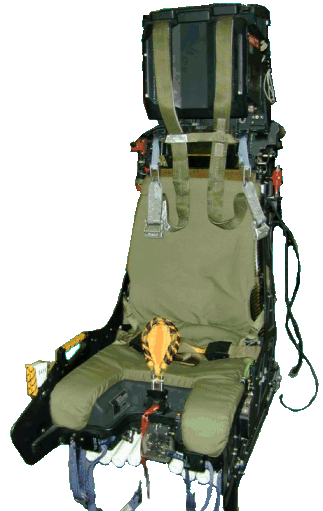The Ejection Site
Martin-Baker SJU-17 (Mk. 14)NACES
 The Naval Aircrew Ejection Seat (NACES) seat was developed to take aircrew safety and survival to a higher level of control. Used in the F/A-18, F-14D, and T-45, the NACES is the most advanced seat used in the United States Navy inventory. The NACES uses a digital electonic sequencer along with airspeed sensors and electrically-fired systems on the seat to allow for five separate modes of operation. The various versions of the Mk. 14 NACES are designated SJU-17 with a suffix letter for the different variants. For example, the main picture here shows a SJU-17A seat which is for the F/A-18 single seat or front cockpit seat on a dual seat aircraft. Version differences include mainly seat bucket shape, headrest and canopy breaker configuration, and other changes to accomodate the various cockpit requirements.
The Naval Aircrew Ejection Seat (NACES) seat was developed to take aircrew safety and survival to a higher level of control. Used in the F/A-18, F-14D, and T-45, the NACES is the most advanced seat used in the United States Navy inventory. The NACES uses a digital electonic sequencer along with airspeed sensors and electrically-fired systems on the seat to allow for five separate modes of operation. The various versions of the Mk. 14 NACES are designated SJU-17 with a suffix letter for the different variants. For example, the main picture here shows a SJU-17A seat which is for the F/A-18 single seat or front cockpit seat on a dual seat aircraft. Version differences include mainly seat bucket shape, headrest and canopy breaker configuration, and other changes to accomodate the various cockpit requirements.
Beyond the computer controlled firing sequence, it uses the same basic frame from the Mk. 10 series of seats including the tubular seat adjustment rails which allow for ease of disassembly. The drogue gun has been replaced with a rocket-deployed system which moves the drogue parachute from the headrest to the large tubular structure on the top right of the main beam assembly. With the addition of the Electronic sequencer, the scissor shackle has been eliminated. The main recovery parachute is housed in the headrest and deployed by a rocket which is located on the left main beam assembly. The sequencer computer module is a flat box which fits under the headrest, just above the shoulder harness. Protruding from the rear on either side of the headrest are the shielded squib cables.
The sequencer is actuated by dual thermal batteries which are located on the main beam on the lower left side of the seat. These batteries are in turn actuated by hot gas from the duel initiators located under the seat firing handle at the front of the seat bucket.
Typically of USN seats, the survival kit contains the emergency oxygen cylinders. The survival kit consists of a composite lid from which is suspended the survival kit and raft packs. The seat is fitted for the MA-2 type torso harness.
The seat is propelled out of the aircraft by means of a single three-tubed catapult between the main beams, and is continued in accelleration by means of a typical Martin-Baker underseat rocket. These units, and the drogue gun and other features of the seat are actuated by electrically fired squibs controlled by the sequencer. These functions even include the deployment of the pitot tubes for sensing the airspeed of the ejection. The pitots are normally stowed behind the headrest and are hinged at the lower end to deploy into the airstream on either side of the headrest.
This ejection seat was on display at theSAFE Association History of Escape Systems and the
Evolution of Manikins Display during the SAFE Association 40th annual Symposium, October 2002
Thanks to Chris Woodul for the photos of the T-45 SJU-17 NACES.
 The Naval Aircrew Ejection Seat (NACES) seat was developed to take aircrew safety and survival to a higher level of control. Used in the F/A-18, F-14D, and T-45, the NACES is the most advanced seat used in the United States Navy inventory. The NACES uses a digital electonic sequencer along with airspeed sensors and electrically-fired systems on the seat to allow for five separate modes of operation. The various versions of the Mk. 14 NACES are designated SJU-17 with a suffix letter for the different variants. For example, the main picture here shows a SJU-17A seat which is for the F/A-18 single seat or front cockpit seat on a dual seat aircraft. Version differences include mainly seat bucket shape, headrest and canopy breaker configuration, and other changes to accomodate the various cockpit requirements.
The Naval Aircrew Ejection Seat (NACES) seat was developed to take aircrew safety and survival to a higher level of control. Used in the F/A-18, F-14D, and T-45, the NACES is the most advanced seat used in the United States Navy inventory. The NACES uses a digital electonic sequencer along with airspeed sensors and electrically-fired systems on the seat to allow for five separate modes of operation. The various versions of the Mk. 14 NACES are designated SJU-17 with a suffix letter for the different variants. For example, the main picture here shows a SJU-17A seat which is for the F/A-18 single seat or front cockpit seat on a dual seat aircraft. Version differences include mainly seat bucket shape, headrest and canopy breaker configuration, and other changes to accomodate the various cockpit requirements.